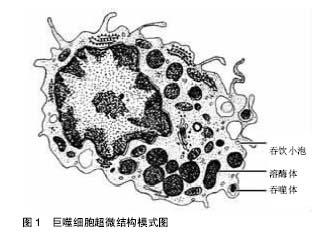| [1] Kurtz S,Ong K,Lau E,et al. Projections of primary and revision hip and knee arthroplasty in the United States from 2005 to 2030. Bone Joint Surg Am. 2007;89:780-785.[2] Inacio MC,Ake CF,Paxton EW,et al.Sex and risk of hip implant failure:assessing total hip arthroplasty outcomes in the United States. JAMA Intern Med. 2013;173(6):435-441.[3] Marshall A, Ries MD, Paprosky W,et al.How prevalent are implant wear and osteolysis, and how has the scope of osteolysis changed since 2000? J Am Acad Orthop Surg. 2008;16 (Suppl 1): S1-S6.[4] Wynn TA,Chawla A,Pollard JW.Macrophage biology in development, homeostasis and disease. Nature. 2013;496 (7446):445-455.[5] Martinez FO,Sica A, Mantovani A,et al.Macrophage activation and polarization. Front Biosci. 2008;13:453-461. [6] Chaudhuri A.Regulation of macrophage polarization by RON receptor tyrosine kinase Signaling.Front Immunol. 2014;5:546.[7] Mazzon C,Zanotti L,Wang L,et al.CCRL2 regulates M1/M2 polarization during EAE recovery phase.J Leukoc Biol. 2016;99(6): 1027-1033.[8] Glass CK,Natoli G.Molecular control of activation and priming in macrophages. Nature Immunol. 2015;17(1):26-33.[9] Nguyen KD,Yifu Q,Xiaojin C,et al.Alternatively activated macrophages produce catecho-amines to sustain adaptive thermogenesis.Nature. 2011;480(7375):104-108.[10] Liu X,Liu J,Zhao S,et al.Interleukin-4 is essential for microglia/ macrophage M2 polarization and long-term recovery after cerebral ischemia.Stroke. 2016;47(2):498-504.[11] Binger KJ,Gebhardt M,Heinig M,et al.High salt reduces the activation of IL-4 and IL-13 stimulated macrophages.J Clin Invest. 2015;125(11):4223-4238.[12] Zhu Y,Tan W,Demetriades AM,et al.IL-17A neutralization alleviated ocular neovascularization by promoting M2 and mitigating M1 macrophage polarization.Immunology. 2016;147(4):414-428.[13] Ilao NB,Lu Mil,Fan YH,et al.Macrophages in tumor microenvironments and the progression of tumors.Clin Dev Immunol. 2012;2012:948098.[14] Buchacher T,Ohradanova-Repic A,Stockinger H,et al.M2 polarization of human macrophages favors survival of the intracellular pathogen chlamydia pneumoniae. PLoS One. 2015; 10(11):e0143593.[15] Khallou-Laschet J,Varthaman A,Fornasa G,et al. Macrophage plasticity in experimental atherosclerosis. PLoS One. 2010;5(1): e8852.[16] Bourlier V,Zakaroff-Girard A,Miranville A,et al.Remodeling phenotype of human subcutaneous adipose tissue macrophages. Circulation. 2008;117(6):806-815.[17] Lumeng CN,Bodzin JL,Saltiel AR.Obesity induces a phenotypic switch in adipose tissue macrophage polarization. J Clin Invest. 2007;117(1):175-184.[18] Li K,Guo Q,Wang CN,et al.Comparative analysis of phenotypes of classically(M1) and alternatively(M2) activated macrophages.Curr Immunol. 2008;28(3):177-183.[19] Hall CJ,Boyle RH,Astin JW,et al.Immunoresponsive gene 1 augments bactericidal activity of macrophage-lineage cells by regulating beta-oxidation-dependent mitochondrial ROS production.Cell Metabol. 2013;18(2):265-278.[20] Gordon S,Martinez FO. Alternative activation of macrophages:mechanism and functions. Immunity. 2010;32: 593-604.[21] Luyendyk JP, Schabbauer GA, Tencati M, et al. Genetic analysis of the role of the P13K-Akt pathway in lipopolysaccharide-induced cytokine and tissue factor gene expression in monocytes/macrophages. Immunol. 2008;180(6):4218-4226.[22] Xu F, Kang Y, Zhang H, et al. AKT1-mediated regulation of macrophage polarization in a murine model of Staphylococcus aureus pulmonary infection.Infect Dis. 2013;208(3):528-538.[23] Kono Y,Kawakami S,Higuchi Y,et al.In vitro evaluation of inhibitory effect of nuclear factor -kappaB activity by small interfering RNA on pro-tumor characteristics of M2- like macrophages. Biol Pharm Bull. 2014;37(1):137-144.[24] Hah YS,Cheon YH,Lim HS,et al.Myeloid deletion of SIRT1 aggravates serum transfer arthritis in mice via nuclear factor-kappaB activation.PLoS One. 2014;9(2):e87733.[25] Gadang V,Kohli R,Myronovych A,et al.MLK3 promotes metabolic dysfunction induced by saturated fatty acid-enriched diet.Am J Physiol Endocrinol Metab. 2013;305:E549-556.[26] Ma LJ,Corsa BA, Zhou J,et al.Angiotensin type1 receptor modulates macrophage polarization and renal injury in obesity.Am J Physiol Renal Physiol. 2011;300:F1203-1213.[27] Obstfeld AE,Sugaru E,Thearle M,et al.C-C chemokine receptor 2 (CCR2) regulates the hepatic recruitment of myeloid cells that promote obesity-induced hepatic steatosis.Diabetes. 2010;59:916-925.[28] Kang K,Reilly SM,Karabacak V,et al.Adipocyte-derived Th2cytokines and myeloid PPARdelta regulate macrophage polarization and insulin sensitivity.Cell Metab. 2008;7:485-495.[29] Rao AJ,Gibon E,Ma T,et al. Revision joint replacement,wear par-ticles,and macrophage polarization.Acta Biomaterialia. 2012; 8(7) :2815-2823.[30] Chen W,Li Z,Guo Y,et al.Wear particles impair antimicrobial activity via suppression of reactive oxygen species generation and ERKL/2 phosphorylation in activated macrophages.Inflammation. 2015;38(3):1289-1296.[31] Purdue E.Alternative macrophage activation in periprosthetic osteolysis.Autoimmunity.2008;41:212-217.[32] Mosser DM, Edwards JP.Exploring the full spectrum of macrophage activation.Nat Rev Immunol. 2008;8:958-969.[33] Takeuch O,Akira S.Epigenetic control of macrophage polarization.Eur J Immunol.2011;41:2490-2493.[34] Ho VW,Sly LM.Derivation and characterization of murine alternatively activated (M2) macrophages. Methods Mol Biol. 2009;531:173-185.[35] Koulouvaris P,Ly K,Ivashkiv LB,et al.Expression profiling reveals alternative macrophage activation and impaired osteogenesis in periprosthetic osteolysis.J Orthop Res.2008;26:106-116.[36] Rao AJ, Gibon E, Ma T,et al.Revision joint replacement,wear particles,and macrophage polarization.Acta Biomater.2012;8: 2815-2823.[37] Maitra R,Clement CC,Crisi GM,et al.Immunogenecity of modified alkane polymers is mediated through TLR1/2 activation. PLoS ONE.2013; 3: e2438.[38] Potnis PA,Dutta DK,Wood SC.Toll-like receptor 4 signaling pathway mediates proinflammatory immune response to cobalt-alloy particles.Cell Immunol.2013;282:53-65.[39] Konttinen YT,Pajarinen J.Adverse reactions to metal-on-metal implants.Nat Rev Rheumatol.2013;(9):5-6.[40] Pearl JI,Ma T,Irani AR,et al.Role of the toll-like receptor pathway in the recognition of orthopedic implant wear-debris particles. Biomaterials.2011;32:5535-5542.[41] Joseph KA, Yao ZY. Macrophage polarization in response to wear particles in vitro.Cell Mol Immunol.2013;10(6):471-482.[42] Kim SY,Choi YJ, Joung SM, et al.Hypoxic stress up-regulates the expression of toll-like receptor 4 in macrophages via hypoxia-inducible factor.Immunology.2010;129:516-524.[43] Pajarinen J,Kouri VP,Jämsen E,et al. The response of macrophages to titanium particles is determined by macrophage polarization.Acta Biomater.2013;9:9229-9240.[44] Konttinen YT,Pajarinen J,Takakubo Y, et al.Macrophage polarization and activation in response to implant debris:influence by "particle disease" and "ion disease".J Long Term Eff Med Implants. 2014;24(4):267-281.[45] Murray PJ,Wynn TA.Protective and pathogenic functions of macrophage subsets.Nat Rev Immunol.2011;11:723-737.[46] Jämsen E,Kouri VP,Olkkonen J, et al.Characterization of macrophage polarizing cytokines in the aseptic loosening of total hip replacements.J Orthop Res. 2014;32(9)1241-1246.[47] Jämsen E,Kouri VP, Ainoia M, et al Correlations between macrophage polarizing cytokines, inflammatory mediators, osteoclast activity, and toll-like receptors in tissues around aseptically loosened hip implants.J Biomed Mater Res A.2017; 105(2):454-463.[48] Trindade MC,Nakashima Y, Lind M, et al.Interleukin-4 inhibits granulocyte-macrophage colony-stimulating factor, interleukin-6, and tumor necrosis factor-α expression by human monocytes in response to polymethylmethacrylate particle challenge in vitro.J Orthop Res.1999;17(6):797-802.[49] Im GI, Han JD. Suppressive effects of interleukin-4 and interleukin-10 on the production of proinflammatory cytokines induced by titanium-alloy particles. Biomed Mater Res. 2001;58: 531-536.[50] Pajarinen J,Kouri VP,Jamsen E,et al.The response of macrophages to titanium particles is determined by macrophage polarization.Acta Biomater.2013;9:9229-9240.[51] Jiang J, Jia T, Gong W, et al.Macrophage polarization in IL-10 treatment of particle-induced inflammation and osteolysis. Am J Pathol. 2016;186(1):57-66.[52] Li B, Hu Y, Zhao Y, et al. Curcumin attenuates titanium particle-induced inflammation by regulating macrophage polarization in vitro and in vivo. Front Immunol. 2017;8:55. |
.jpg)


.jpg)